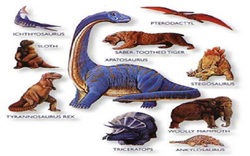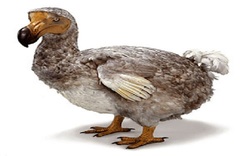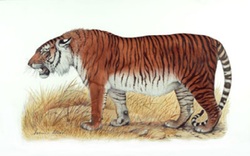Top Five Oldest Species (Animals)
Aurchs

The aurochs or urus (Bos
primigenius),
the ancestor of domestic cattle, was
a type of huge wild cattle which inhabited Europe, Asia and North Africa, but
is now extinct; it
survived in Europe until 1627.
The aurochs was far larger than most modern domestic cattle with a shoulder height of 2 metres (6.6 ft) and weighing 1,000 kilograms (2,200 lb). The aurochs was regarded as a challenging quarry animal, contributing to its extinction. The last recorded aurochs, a female, died in 1627 in the Jaktorów Forest, Poland, and her skull is now the property of Livrustkammaren in Stockholm.
Aurochs appear in prehistoric cave paintings, Julius Caesar's The Gallic War and as the national symbol of many European countries, states and cities such as Alba-Iulia, Kaunas, Romania, Moldavia, Mecklenburg, and Uri. The Swiss canton Uri was actually named after this animal species.
Domestication of bovines occurred in several parts of the world but at roughly the same time, about 8,000 years ago, possibly all derived from the aurochs. In 1920, the Heck brothers, who were German biologists, attempted to recreate aurochs. The resulting cattle are known as Heck cattle or Reconstructed Aurochs, and number in the thousands in Europe today. However, they are genetically and physiologically distinct from aurochs. The Heck brothers' aurochs also have a pale yellow dorsal stripe, instead of white.
The aurochs was far larger than most modern domestic cattle with a shoulder height of 2 metres (6.6 ft) and weighing 1,000 kilograms (2,200 lb). The aurochs was regarded as a challenging quarry animal, contributing to its extinction. The last recorded aurochs, a female, died in 1627 in the Jaktorów Forest, Poland, and her skull is now the property of Livrustkammaren in Stockholm.
Aurochs appear in prehistoric cave paintings, Julius Caesar's The Gallic War and as the national symbol of many European countries, states and cities such as Alba-Iulia, Kaunas, Romania, Moldavia, Mecklenburg, and Uri. The Swiss canton Uri was actually named after this animal species.
Domestication of bovines occurred in several parts of the world but at roughly the same time, about 8,000 years ago, possibly all derived from the aurochs. In 1920, the Heck brothers, who were German biologists, attempted to recreate aurochs. The resulting cattle are known as Heck cattle or Reconstructed Aurochs, and number in the thousands in Europe today. However, they are genetically and physiologically distinct from aurochs. The Heck brothers' aurochs also have a pale yellow dorsal stripe, instead of white.
Dinosaurs

Dinosaurs are a variety of extinct
animals were over 160 million years is the dominant vertebrates on the Earth's
surface, and in particular since the late Tertiary (about 230 million years)
until the end of the Cretaceous period (about 65 million years). Ceased to most
types of dinosaurs and the factions during the Cretaceous extinction event -
triangular
Dodo Bird

The
dodo (Raphus
cucullatus)
was a flightless bird
endemic
to the Indian Ocean
island of Mauritius.
Related to pigeons and doves,
it stood about a meter (3.3 feet) tall, weighing about 20 kilograms
(44 lb),
living on fruit, and nesting on the ground.
The dodo has been extinct since the mid-to-late 17th century.[2] It is commonly used as the archetype of an extinct species because its extinction occurred during recorded human history and was directly attributable to human activity.
The phrase "dead as a dodo" means undoubtedly and unquestionably dead, whilst the phrase "to go the way of the dodo" means to become extinct or obsolete, to fall out of common usage or practice, or to become a thing of the past.
The dodo has been extinct since the mid-to-late 17th century.[2] It is commonly used as the archetype of an extinct species because its extinction occurred during recorded human history and was directly attributable to human activity.
The phrase "dead as a dodo" means undoubtedly and unquestionably dead, whilst the phrase "to go the way of the dodo" means to become extinct or obsolete, to fall out of common usage or practice, or to become a thing of the past.
Caspian Tiger

§The Caspian
tiger, also known as the Persian
tiger, Turanian
tiger, Mazandaran
tiger,[2] or Hyrcanian
tiger[3] was found in Iran,
Armenia, Azerbaijan, Iraq,
Afghanistan, Turkey, Mongolia, Kazakhstan, Kyrgyzstan, Tajikistan, Turkmenistan, and Uzbekistan until it apparently became extinct in the late 1950s, though there
have been several alleged sightings of the tiger in the more recent years.[4] First thought to have been its own
distinct subspecies, genetic research in 2009 proved
that the animal was closely related to the Siberian tiger (P. t. altaica).[5] Separated by only one letter of
genetic code,[dubious
– discuss] it is believed that the two split
off from each other only in the past century. Some researchers[who?] suggest that it may be possible to
reintroduce the closely related Siberian Tiger to the Caspian tiger's
historical range in hopes of recreating this now-extinct big cat.
Carthaginian elephant

§The
North
African Elephant
(Loxodonta africana pharaoensis) was a possible subspecies of the African Bush Elephant (Loxodonta africana), or possibly a separate elephant
species, that existed in North Africa until becoming extinct in Ancient Roman times. These were the famous war elephants used by Carthage in the Punic Wars, their conflict with the Roman Republic. Although the subspecies has been
formally described,[1][2] it has not been widely recognized
by taxonomists. Other names for this animal include the North
African Forest Elephant,
Carthaginian
Elephant, and Atlas
Elephant. Originally, its natural range
probably extended across North Africa and down to the present Sudanese and Eritrean coasts.
